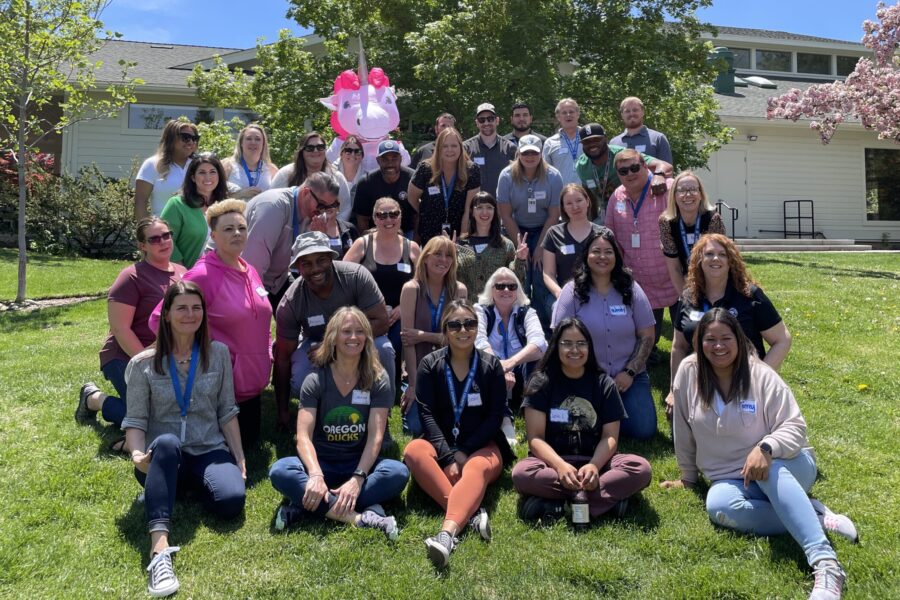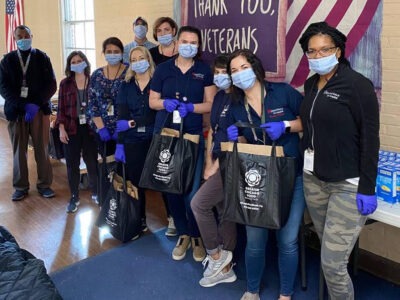Over the years, homeless response leaders in Washoe County, Nevada, have often been asked: “How many people are currently experiencing homelessness in our community?”
“And no one could answer that question,” explained Catrina Peters, Homeless Services Coordinator with Washoe County Housing and Homeless Services.
Now they can. Built for Zero has officially recognized that Washoe County has reached quality data, which indicates a community has a comprehensive by-name data source of every person experiencing homelessness within a specific population, updated in real-time. Using information collected and shared with their consent, each person on the list has a file that includes their name, homeless history and housing needs.
However, Washoe County’s accomplishment is especially unique. They are one of the few Built for Zero communities to simultaneously reach the quality data milestone for two subpopulations — veterans and people experiencing chronic homelessness — and for a broader category of all single adults experiencing homelessness. This “all single adult” population includes veteran and chronic subpopulations, along with all other single adults experiencing homelessness who are not part of those subpopulations.
By having hit this more rigorous quality data standard, Washoe County has demonstrated that their system is robust enough to track the changing size, composition, and dynamics of an entire single adult population with confidence in real time. Traditionally, Built for Zero communities begin by focusing on just one subset of people experiencing homelessness at a time, but the Washoe County team was up to the challenge.
“That’s part of why it took two years, but at the end of the day after two years, we had this really comprehensive data picture,” Peters said.
By accounting for everyone experiencing homelessness, Washoe County has strengthened their system by finding gaps, identifying areas for improvement, and highlighting what is working well. This collective approach ensures funds and resources are allocated to the highest need, as the community continues to reduce homelessness on its way to another milestone — functional zero.
Centralizing the data
Washoe County, Nevada, encompasses 6,500 square miles, with the urban center of Reno to the south and a largely rural area to the north. Historically, the area was an affordable place to live. However, like many other communities, they have more recently experienced severe housing challenges, including rising rents and dramatic increases in housing costs, especially for lower-income residents.
During the COVID-19 pandemic, homelessness became a lightning rod topic in their community, as unsheltered homelessness had visibly increased along the main corridors of the urban center. Washoe County homeless response leaders felt it was time to dive into the work in a new way.
The community joined Built for Zero in April 2020, but began working on their quality data in January 2021. At that time, only 42% of homeless service providers in the community were entering data on the clients they were serving into a shared database called the Homeless Management Information System (HMIS). Any organization or agency that received homelessness funding was required to report data into HMIS.
As part of their efforts to reach quality data, team leaders began a push to increase usage of the shared database, emphasizing that it would help standardize outcome metrics and allow everyone to define success in the same way across the homeless response system. Participation has now surpassed 90%, with 64 programs and 27 agencies reporting data.
“You can’t solve a problem that you can’t see. And you need that data piece to also see that our investments and our program changes are getting us where we want to go,” Peters said. “We don’t want to just do change for the sake of change. We don’t want to waste precious resources. We want to see dollars and effort going to programs that are going to solve homelessness.”
Built for Zero’s quality data standard gives communities confidence in the data representing their system — they know it’s reliable, accurate, and up-to-date. For a community the size of Washoe County, having this confidence in their data was essential. At their peak, they had real-time records of almost 2,500 people experiencing homelessness in their community.
Over the last six months, Washoe County has made huge strides, reducing that number by 28%, with 1,800 people on their list now. And they’re still seeing a consistent downward trend. Now, if someone asks how many people are experiencing homelessness in the community, it’s not such a challenge to provide a response.
“The only reason we’re able to answer that question now and do detailed analysis on it so we can drive that number down is through using a centralized database,” Peters said. “It helps people see the power of the data.”
Strengthening the case conferencing muscle
The importance of having all service providers actively engaged in the entire system goes beyond just contributing data to a central database. Having an up-to-date, common pool of information enables staff at each agency to track which clients are being served by whom. This approach allows providers to prevent redundant efforts to more efficiently meet each client’s unique needs to secure permanent housing.
One of the key ways Washoe County puts that focus into action is through case conferencing, a recurring meeting bringing together representatives across a community’s homeless response system to problem-solve on ways to remove barriers to help house clients faster.
Every other week, the Washoe County team holds these collaborative meetings for each subpopulation of people experiencing homelessness, where they review clients in their central database who are enrolled in their street outreach program or located at an emergency shelter. The purpose of this meeting is to talk through, among all of the providers and agency representatives, “How do we get this person housed?”
“I think that’s really where the human element takes over,” Peters noted. “We’ve got data, and that’s critically important to identify who’s experiencing homelessness. But getting all our service providers around the table to talk about how we’re going to get this person housed — that’s really where the magic is.”

“I think that’s really where the human element takes over. We’ve got data, and that’s critically important to identify who’s experiencing homelessness. But getting all our service providers around the table to talk about how we’re going to get this person housed — that’s really where the magic is.”
— Catrina Peters, Homeless Services Coordinator with Washoe County Housing and Homeless Services
Case conferencing participants are trained on how to house with urgency and lead with action steps, all with the goal of reducing the length of time their neighbors experience homelessness. Part of learning case conferencing is encouraging attendees to embrace change and test new ideas, because even failed attempts tell you more about your system.
“We just really pull folks in. People might not understand the case conferencing model at the first meeting, but we continue to invite folks to make sure we have everybody around the table and to do our best to bring everybody on board,” Peters said.
Case conferencing is known as a practice because it is a skill that must be exercised and strengthened — and Washoe County took deliberate steps to “build their case conferencing muscle.” The case conferencing team started with a pilot meeting, zeroing in on a small subset of clients, determining what information was most valuable to share and in what format and frequency.
“We didn’t want to let perfection be the enemy of progress, so we just took that first step and continued to refine the model. And now we have five very robust groups that have built up that muscle of talking through the data in a really beneficial way, identifying the action steps needed to get that person housed,” she said.
Coordination across the system has also improved outreach efforts — a critical component of this work. People experiencing unsheltered homelessness tend to move around, making it challenging for providers to locate them, which is particularly crucial when they have housing lined up. That’s where the case conferencing meetings can have their most impact.
“That group comes together every other week and works in this tremendously collaborative way through that power of shared data and a shared database,” Peters said. “We’ve seen really incredible work housing people directly from unsheltered homelessness through that collaborative effort and coordination.”
Keeping the foot on the gas
The Washoe County team is proud of hitting this significant milestone, but they’re not slowing down. “In some ways, the work just started, now that we finally have the clear picture,” noted Dana Searcy, Division Director, Washoe County Housing and Homeless Services.
They’re now prioritizing collecting more detailed information on inflow and outflow into homelessness — how, why, when, and where people enter and exit the homeless response system. The community team also knows that increasing the number of units for low- and extremely low-income populations is a crucial component to continue to make reductions.
“Now that we’ve really gotten our arms around the scope of this problem, and we’ve gotten data centralized and one location, it provides us the opportunity to do that more detailed analysis,” Peters said. “And I think that is going to be needed to get us to functional zero.”
The Washoe County team plans to move forward intentionally and strategically with these analyses. Part of that intentionality includes their efforts to correct racial inequities in their system, as having centralized, comprehensive data allows them to drill down into where those disparities exist.
Achieving quality data for veterans, chronic, and all single adults is a huge accomplishment, but the Washoe County teams know the work must continue.
“If we take our foot off the gas we’re going to slip backwards. We want to make sure the number keeps going down and we can keep celebrating reductions in homelessness,” Searcy said. “This is the first step in a very long journey.”
The Washoe County team would like to thank all of the community agencies, organizations, and service providers who contribute data to their shared database in the collective work to end homelessness.
| Agency Name | Program Name |
|---|---|
| Bristlecone Family Services | HCHV/EH for Veterans Program |
| Bristlecone Family Services | Transitional Living |
| Bristlecone Family Services | Grant per Diem |
| Catholic Charities Northern Nevada | Emergency Housing Voucher |
| CCNN – Human Services | NHD ESG-CV RRH |
| CCNN – Human Services | NHD ESG-CV Street Outreach |
| City of Reno | Reno Works Program |
| City of Reno | Clean and Safe – Street Outreach |
| City of Reno Housing Authority | Project Based Voucher Program |
| City of Reno Housing Authority | VASH Voucher Program |
| Downtown Reno Partnership | DRP Street Outreach |
| Eddy House | Eddy House – Overnight/Emergency Shelter |
| Eddy House | ESG Emergency Shelter |
| Eddy House | Street Outreach |
| Eddy House | Eddy House – Community Living |
| Eddy House | Transitional Living Program |
| Health Plan of Nevada – Northern Nevada | Emergency Housing Voucher |
| Health Plan of Nevada – Northern Nevada | HPN Outreach |
| Hosanna Home | Hosanna Home – Transitional Housing Program |
| Karma Box Project | Safe Camp |
| Karma Box Project | Street Keepers |
| Karma Box Project | River Stewards |
| Karma Box Project | Street Outreach ESG-CV |
| Nation’s Finest-NN | HCHV Montello |
| Nation’s Finest-NN | Reno HP Program |
| Nation’s Finest-NN | Reno RRH Program |
| Nevada Youth Empowerment Project | Community Living Program |
| Nevada Youth Empowerment Project | Sonder House |
| Northern Nevada Adult Mental Health Services | Shelter Plus Care Program |
| Northern Nevada HOPES | HOPWA STRMU |
| Northern Nevada HOPES | Northern Nevada HOPES-Homelessness Prevention-NHD-ESG-CV |
| Restart Homeless Services | Moving On–Emergency Housing Voucher |
| Restart Homeless Services | Anchor Plus Expansion |
| Restart Homeless Services | Rapid Re-housing for Families |
| Restart Homeless Services | RRH for Individuals |
| Restart Homeless Services | Reno Works Program |
| Restart Homeless Services | PATH Program |
| Restart Homeless Services | Reno Outreach |
| Safe Embrace | COR RRH |
| Safe Embrace | ESG-CV RRH |
| Safe Embrace | Rapid Rehousing |
| Safe Embrace | Rapid Rehousing 2 |
| Safe Embrace | Rapid Rehousing 2102 |
| Safe Embrace | Transitional Housing |
| Step 1 | Transitional Housing Program |
| Steps to New Freedom | Steps to New Freedom |
| The Children’s Cabinet, Inc.- RHY | RHY Project – BCP Emergency Shelter |
| The Children’s Cabinet, Inc.- RHY | RHY Project – BCP Prevention |
| The Children’s Cabinet, Inc.- RHY | RHY Project – SOP |
| The Empowerment Center | Transitional Housing |
| The Reno Initiative for Shelter and Equality | RISE Clean and Safe |
| VA Sierra NV HCS-Northern Nevada | Health Care for Homeless Veterans-NN |
| Vitality Unlimited – NN | Vitality Veterans Housing Program |
| Volunteers of America | Nevada Cares Campus |
| Volunteers of America | The Village on Sage Street |
| Washoe County Housing and Homeless Services | WCHHS Emergency Housing Voucher |
| Washoe County Human Services Agency | Men’s CrossRoads |
| Washoe County Human Services Agency | Our Place Family Shelter |
| Washoe County Human Services Agency | Our Place Women’s Home |
| Washoe County Human Services Agency | Women’s CrossRoads |
| Washoe County Human Services Agency | Emergency Housing Voucher |
| Washoe County Human Services Agency | Our Home |
| Washoe County Human Services Agency | Permanent Supportive Housing Program |
| Washoe County Human Services Agency | Shelter Plus Care |
| Well Care Northern Nevada | Northern Nevada WC Health BH Program |
| Westcare NN | VA Home Front Program |




